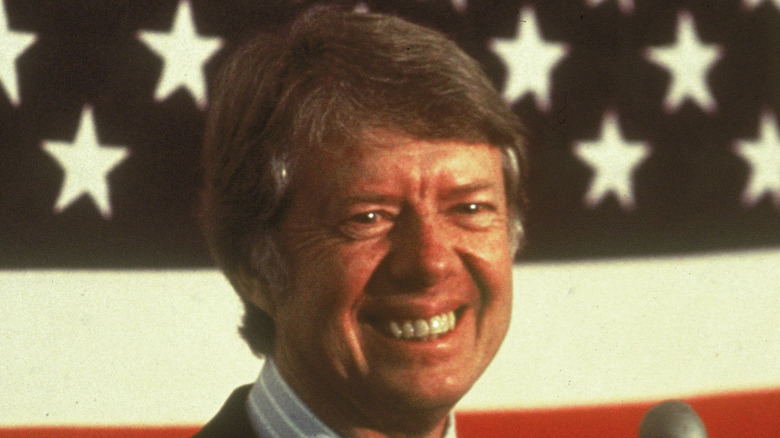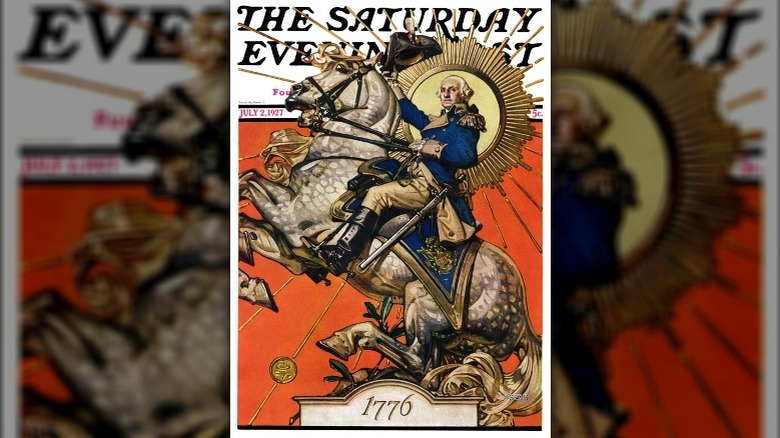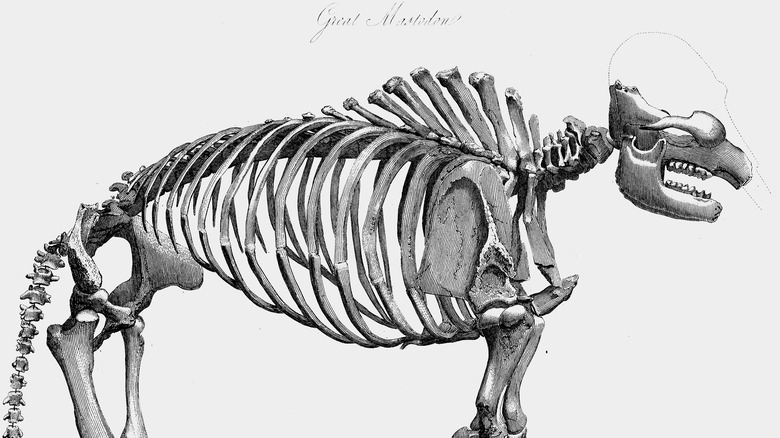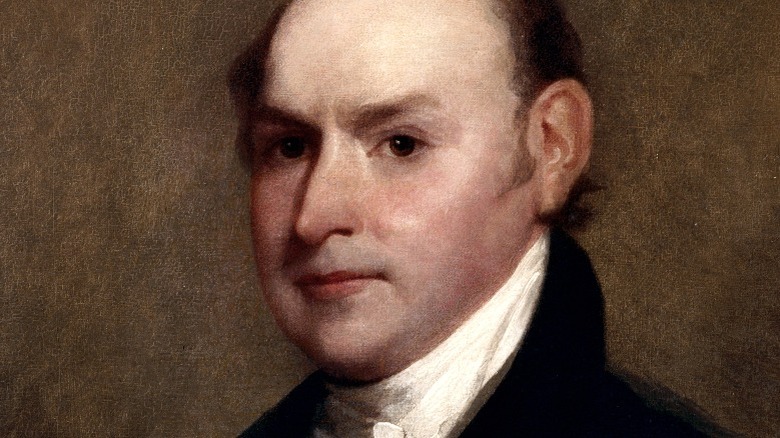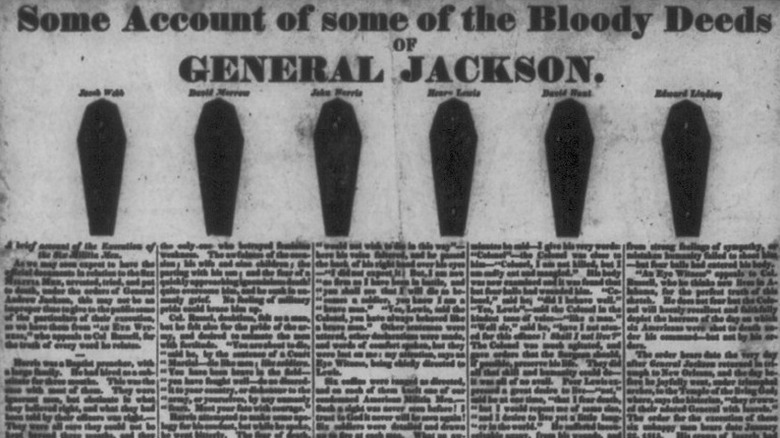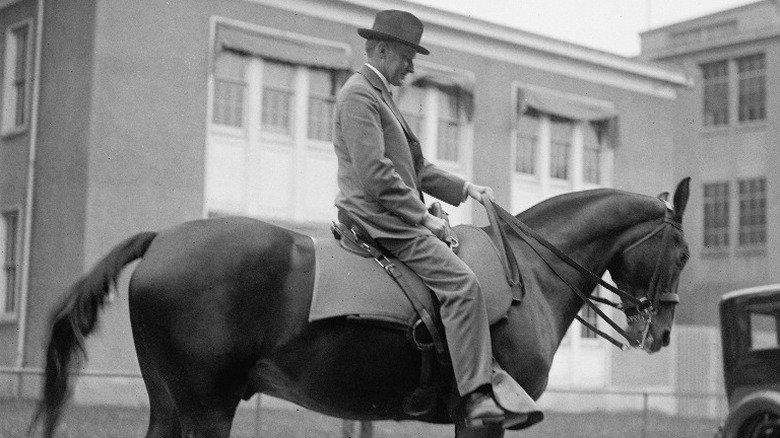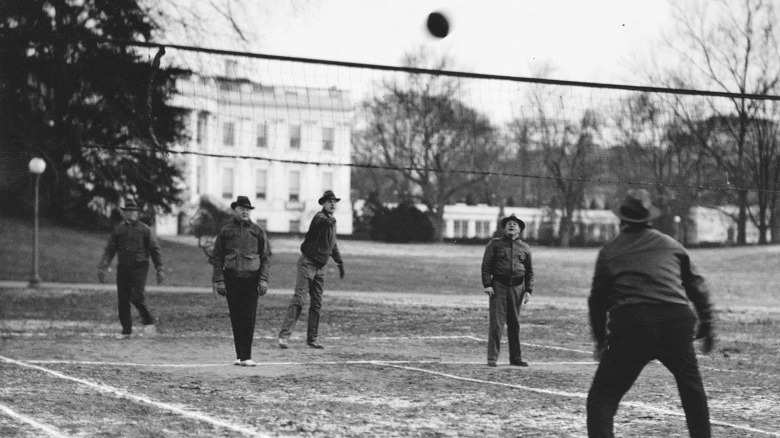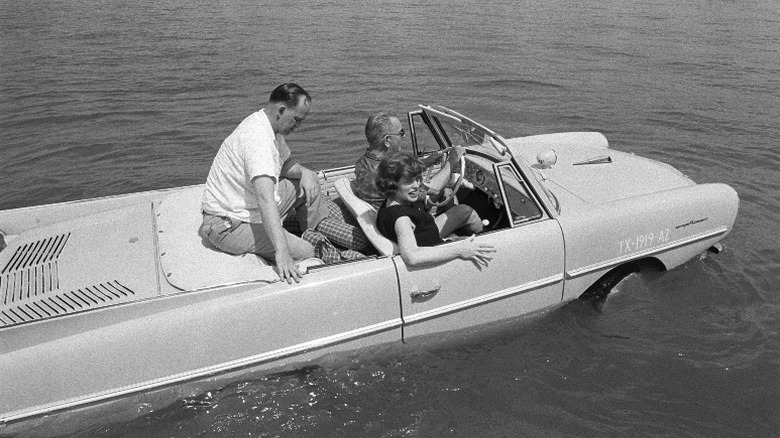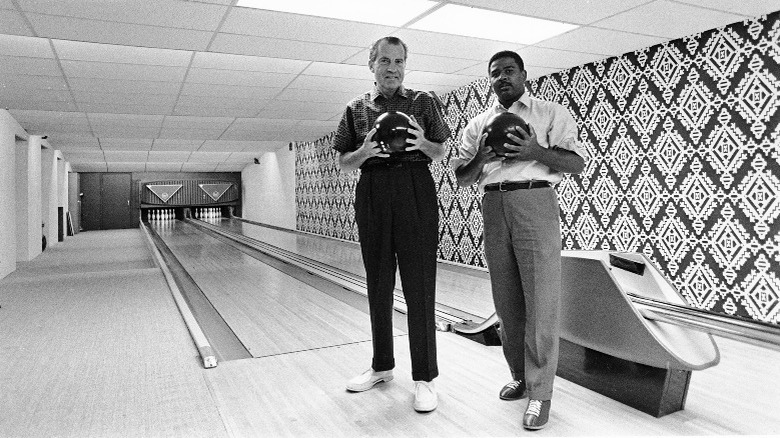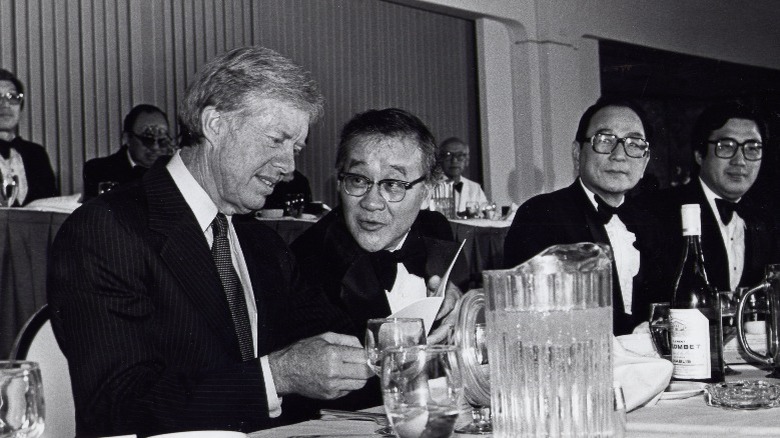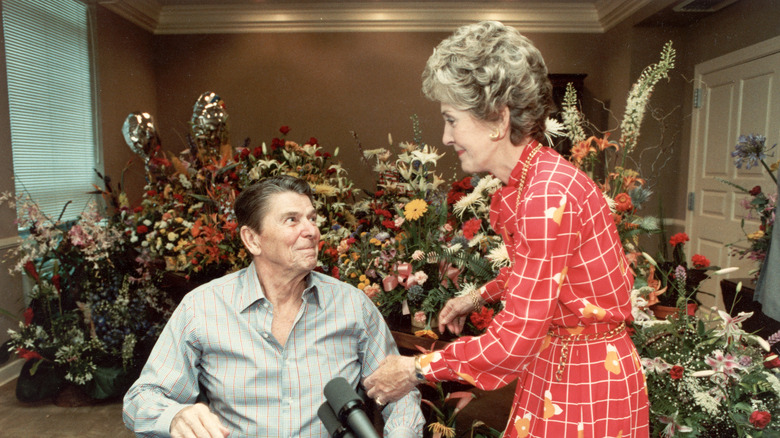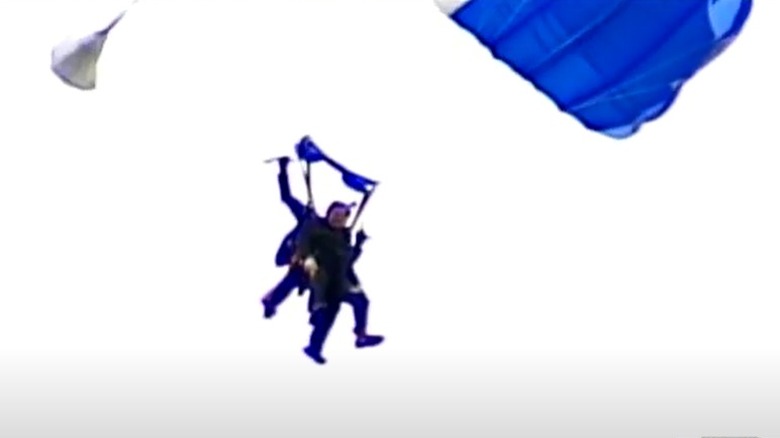The Quirkiest Hobbies And Habits Of American Presidents
No one gets to the political heights of the United States presidency without being a little odd. After all, while most humans need some encouragement or a self-esteem boost to go about their normal, everyday lives, these men looked inward and thought, "Yes, I should be the most powerful person in the world. I would be very good at it." Then they not only fight in the toughest political arena for the job but manage to come out on top, then happily take on one of the hardest, most stressful jobs in the world.
Even running the free world isn't a 24/7 job, though. These guys may be different, but they aren't robots; they need to take time off every now and then. Still, it should come as no surprise that when many presidents, ex-presidents, or soon-to-be-presidents found themselves with a little downtime, they didn't always fill it with the standard presidential hobbies of golf or ... well, mostly golf. Instead, they fixated on weirdly specific obsessions, or unusual exercise routines, or niche recreational activities that were made stranger because they were the guys doing it. Here are some of the quirkiest hobbies and habits of American presidents.
George Washington
Based on the amount of correspondence in the National Archives on the subject, there was a pretty good chance that if you were an acquaintance of George Washington, at some point he was going to write you a too-detailed letter about the breeding habits of his horses and donkeys, specifically with each other. Washington, not content with helping create a new country, wanted to introduce to that country a new animal: the mule.
According to The American Mule Museum, Washington knew mules could improve the U.S. agricultural sector. The problem was that mules are born sterile, so you have to keep breeding male donkeys (Jacks) with female horses (mare) to produce them. For Washington, no regular American donkeys would do; he wanted ones from Spain. So he found himself writing to people over and over again trying to get one. To Robert Townsend Hooe in 1784 he insisted, "An ordinary Jack I do not desire; I will describe therefore such an one as I must have, if I get any — He must be at least fifteen hands high; well formed; in his prime; & one whose abilities for getting Colts can be ensured; for I have been informed, that ... they very frequently have their generative parts so injured by squeezing, as to render them as unfit for the purpose of begetting Colts ..." (via the National Archives).
Washington did get his Spanish Jacks eventually, including one from the king himself, and became the first mule breeder in the U.S.
Thomas Jefferson
While he didn't have the same understanding of what a fossil was as a modern person, Thomas Jefferson was obsessed with the weird skeletons that had been dug up in areas of the young U.S., ones that didn't look like anything found in the rest of the world. These were mastodon fossils but were often interchangeably called "mammoths" by Jefferson and others, as per his 1785 "Notes on the State of Virginia."
In a 1797 seminar, published two years later in Transactions of the American Philosophical Society, the then-vice president theorized, "In the present interior of our continent there is surely space and range enough for ... mammoths and megalonyxes who may subsist there. Our entire ignorance of the immense country to the West and North-West, and of its contents, does not authorize us to say what it does not contain." When he became president and made the Louisiana Purchase, Jefferson sent Merriweather Lewis and William Clark to go see what was out there. But surely, that couldn't have included searching for mastodons, right?
Sadly for Jefferson, they were all long dead. Regardless, in the middle of heading to the rendezvous point with Clark to start their expedition, Lewis took a side trip to Big Bone Lick, where mastodon fossils had been found. He wrote Jefferson a long, detailed letter about how the dig was going. Even after the expedition ended, Clark continued his work for Jefferson, sending him mastodon bones he found.
John Quincy Adams
John Quincy Adams isn't remembered for much in his one term as president, but if there is a fact that is known about him, it's probably that he liked to skinny-dip in the Potomac River. Per The White House Historical Association, in a 1819 diary entry, Adams wrote of swimming, "I find it, as always, conducive to health, cleanliness, and comfort."
In his own diary, contemporary Charles Jared Ingersoll (via "The Life of Charles Jared Ingersoll," by William Montgomery Meigs) wrote that Adams walked a mile to swim in the Potomac River eight days in a row, then, due to low tide, he would take six days off, before starting the cycle again. Ingersoll explained, "Mr. Adams ascribes his uninterrupted health during the several sickly seasons he has lived in Washington to swimming."
While it might be weird today to think of a politician getting naked and swimming in a river that runs right past Washington, D.C., it turned out that Adams probably needed to stick to swimming naked. One time he tried it with clothes on, he almost died. In 1825, the then-president got in an abandoned boat planning to row it across one of the river's tributaries, Tiber Creek, and swim back. But the boat took on water, and when Adams jumped fully clothed into the creek, he had to be rescued from downing by a companion. As Adams wrote in his diary about the incident, "... By the blessing of Heaven our lives were spared ..."
Andrew Jackson
In 1861, The Atlantic reviewed "Life of Andrew Jackson," a new biography of the former president by James Parton. It received high praise from the magazine, particularly noting that the author "lets us see [Jackson] cockfighting, horse-racing, bad-whiskey-drinking, studying law, and fighting by turns, leaving behind him somewhat dubious but on the whole favorable memories ..." Jackson, a divisive figure even in his own day, would become famous for many of his vices, but cockfighting was one of the most controversial. According to "Tennessee: A Short History," by Robert E. Corlew, one acquaintance of Jackson called him "the most roaring, rollicking, game cocking, cardplaying, mischievous fellow that ever lived in Salisbury [North Carolina]."
As explained in a 1993 letter from the deputy director of research at the home of Jackson, known as The Hermitage, there is proof he was involved in cockfighting, although they wrote that there was only one known document actually "putting him on the scene" of a cockfight. Some sources claim Jackson held a few of the fights in the White House itself, although it is not clear what evidence there is for this.
What is known is that his involvement in cockfighting was such a big deal that it was included in the election smear campaign of 1828. One of the "Coffin Broadside" handbills (pictured) not only leveled accusations against Jackson that included murder but also mentioned his love of bloodsport. Jackson wrote, but did not publish, an apology, in which he insisted he hadn't been to a cockfight in at least 13 years.
Calvin Coolidge
There's no easy way to say this: President Calvin Coolidge rode a fake horse. Multiple times a day. Coolidge loved riding but, depending on which source you believe, he either developed an allergy to horses or the Secret Service made him stop riding when he became president or he simply did it so he could "ride" more often than the job allowed. Regardless of why it happened, it is verifiably true that this mechanical horse — a gift from the famously odd health fanatic John Harvey Kellogg – not only existed but was regularly used by the president of the U.S., as often as three times a day.
When the news got out that this was how Coolidge got his exercise, his political rivals reveled in the chance to make fun of him, as did the press –- not just in the U.S. but internationally. According to The Washington Post, a Canadian journalist wrote, "Somehow or other the picture of the President of the United States being bucked and jolted and kicked by a vicious hobbyhorse of wood and steel isn't just the proper caper. It will be difficult for the people of the United States to think of their President as 'a 100 percent he-man' when they know he takes his exercise on a hobby horse."
The ridicule evidently didn't put Coolidge off his hobby, and when he left office in 1929, he took the horse with him.
Herbert Hoover
Herbert Hoover had an astonishingly successful career before he became president of the U.S., but his legacy will always come down to his handling of the early years of the Great Depression. However, perhaps he should really be known for Hoover-ball (pictured).
Invented by the president's doctor, there were a number of rules — three of which applied only to any women who joined Hoover and various government officials for an early morning game. Essentially tennis played with a medicine ball and no racquets, "It required less skill than tennis, was faster and more vigorous, and therefore gave more exercise in a short time," Hoover himself explained years later in his memoir "The Cabinet and the Presidency, 1920-1933."
Nor was the president the only one who was so taken with the game that he thought it important enough to record in the official story of his life. In his own memoirs, the former Secretary of the Interior Ray Lyman Wilbur wrote about the players' dedication to the game: "Except for Sundays, we played [Hoover-ball] every morning of the week, including official holidays. Only absence from Washington kept us away." Usually the participants played through bad weather, and the handful of times weather made play truly impossible, they played inside instead. President Hoover only missed the game once during his whole time in office, which proved how important he believed it was to find 30 minutes in his very busy days to stay fit.
Lyndon Johnson
Lyndon Johnson managed to do some amazing things as president, but as great as the public man could be, everyone who knew him seems to agree that in private, Johnson was a big jerk. He once exposed himself to reporters who were asking questions he didn't like; another time he made a White House staffer come work in the bathroom while Johnson was using it. He also carried out multiple affairs, with his wife wise to his ways. So you can imagine, his idea of a practical joke would probably be pretty cruel.
At his ranch in Texas, Johnson owned one of just a few thousand Amphicars ever built. He kept this quiet, though, so he could terrify his guests. In "The Triumph and Tragedy of Lyndon Johnson: The White House Years," Joseph A. Califano, an aide to the president, recorded his experience as a passenger on a drive around the ranch: "We reached a steep incline at the edge of the lake and the car started rolling rapidly toward the water. The President shouted, 'The brakes don't work! The brakes won't hold! We're going in! We're going under!' The car splashed into the water. I started to get out. Just then, the car leveled, and I realized we were in an Amphicar. The President laughed."
Former Secret Service Agent Mike Howard told CNN that on another occasion, a woman — who couldn't swim — was seriously injured while trying to flee the seemingly sinking car.
Richard Nixon
Considering Richard Nixon left office in disgrace after the Watergate scandal, making him the first and only U.S. president -– so far –- to resign, it's odd to think of him as associated with anything wholesome like the sport of grandpas and 10th birthday parties. However, according to no less a source than the International Bowling Museum and Hall of Fame, Nixon was probably the most avid bowler of all presidents.
The White House already had a bowling alley when the Nixons moved in at the beginning of 1969. At least, it sort of did. While lanes had originally been built in the famous building itself in 1947, eight years later they were moved to a different building on the White House's grounds, and mostly used by staff. The Nixons could have used those facilities (no lower-level aide or reporter wasn't going to tell the president of the United States he had to wait for an open lane), but the couple wanted one closer to home, literally. However, of the many corrupt things Richard Nixon did, building himself a new White House bowling alley with taxpayer dollars was not one of them: the Bowling Museum says it was paid for privately as a gift to the president.
Richard Nixon also appointed professional bowler Andy Varipapa to the President's Council on Physical Fitness and Sports in 1970, per the Bowling Museum, and invited the heads of various U.S. bowling organizations to the White House in 1971.
Jimmy Carter
After leaving the White House, Jimmy Carter famously spent a lot of his time building homes with Habitat for Humanity. But that wasn't the only pastime he filled his very long retirement with. Sure, his official biography at The Carter Center covers his decades of work bringing warring sides around the world to the negotiating table, his help almost completely eliminating Guinea worm disease, the nearly three-dozen books he wrote, and even his dedication to teaching Sunday school. But in 2005, he talked to Wine Spectator about a hobby very close to his heart ... and palate.
Perhaps because of his farmer roots, Carter was an enthusiastic amateur winemaker, complete with his own custom bottle label. He spoke about how it was a family affair: "I generally get my children and grandchildren to come down ... and we go out into the local vineyards and pick around 50 gallons of grapes. I've got an ancient wine press – probably about 250 years old –- that someone gave to me, and I've made the rest of my equipment myself."
Lest you think that winemaking did not contribute to Carter's reputation as an all-around great guy who worked endlessly for peace, he insisted that his hobby actually helped him when working with leaders around the world. Not only could he talk intelligently about wines from their respective countries, but Carter said, "They're always intrigued that I, as a former president, actually make my own wine. It makes a good conversation piece."
[Featured image by Alec.bohlmanusa via Wikimedia Commons | Cropped and scaled | CC BY-SA 4.0]
Ronald Reagan
On March 30, 1981, John Hinckley Jr. attempted to assassinate Ronald Reagan, shooting and seriously injuring the president. Seven years later, according to contemporary reporting by The New York Times, journalist Ted Koppel revealed on "Nightline" that he had a source who informed him that shortly before the attack, a psychic had told first lady Nancy Reagan that "there was going to be an incident on that day."
By 1988, the chatter about the Reagans' interest in astrology was too loud to ignore. While there had long been rumors and the odd news report, the situation finally came to a head, forcing White House Press Secretary Marlin Fitzwater to explain to reporters during an official briefing, "It's true that Mrs. Reagan has an interest in astrology. She has for some time, particularly following the assassination attempt in March of 1981. She was very concerned for her husband's welfare, and astrology has been part of her concern in terms of his activities." Reporters also asked Reagan for comment, and he tried to reassure them that "No policy or decision in my mind has ever been influenced by astrology."
However, it was a big enough deal to the couple that the Ronald Reagan Presidential Library and Museum archives has a section on "Astrology Use by the Reagans." As one of their friends put it to The New York Times, "You have to remember where and how that part of their life started. In Hollywood during the '30s and '40s, astrologers were social equals and friends, they weren't weirdos."
George HW Bush
In 1997, the year he turned 73, the former president George H.W. Bush decided he was going to skydive. Making a parachute jump at any age requires guts, let alone doing it at such an advanced stage of one's life. But Bush Sr. had even more baggage associated with the attempt than almost anyone else in his place would. See, before his late-in-life skydiving adventures, he'd jumped out of a plane once before. It was during World War II when his plane was shot down, and the two men who jumped out alongside him didn't survive the desperate act. Bush Sr. was determined that he'd jump out of plane again, this time on his own terms.
After his 1997 skydiving adventure, the former president went again two years later for his 75th birthday, then every five years for his birthday after that. He a near-death experience on the jump in 1999, when he started spinning out and was unable to pull his ripcord, as retired Army Gen. Hugh Shelton explained to The Fayetteville Observer (via Military.com). On his 80th birthday jump, he decided to go tandem and continued to do so from then on. In 2007, he jumped out of a plane 10 months after getting a hip replacement.
"Just because you're an old guy, you don't have to sit around drooling in the corner," Bush Sr. said (via CBS News). "Get out and do something. Get out and enjoy life." Following his own advice, had he lived just one more year, Retired Sgt. 1st Class Mike Elliott, who was a skydiving buddy of the late president, told ABC11 that Bush Sr. planned on jumping for his 95th birthday as well.
